Electricity on the Aqueduct
Once the Los Angeles Aqueduct was completed in 1913, it made possible more than just bringing water to the city. The force of the water as it dropped thousands of feet on its gravity-fed journey created an opportunity to generate electricity. On March 18, 1917, the San Francisquito Power Plant No. 1 went into service, delivering electricity to Los Angeles over a newly built 115 kV transmission line. The 200 kilowatts from its first generator were the city’s first commercial kilowatts produced by the new Los Angeles Bureau of Power and Light. Units 2 and 3 followed later that spring. When it opened, Power Plant No. 1 supplied more than 70 percent of the city’s electrical needs. It is still operating today, providing a small but steady share of power to Los Angeles. |
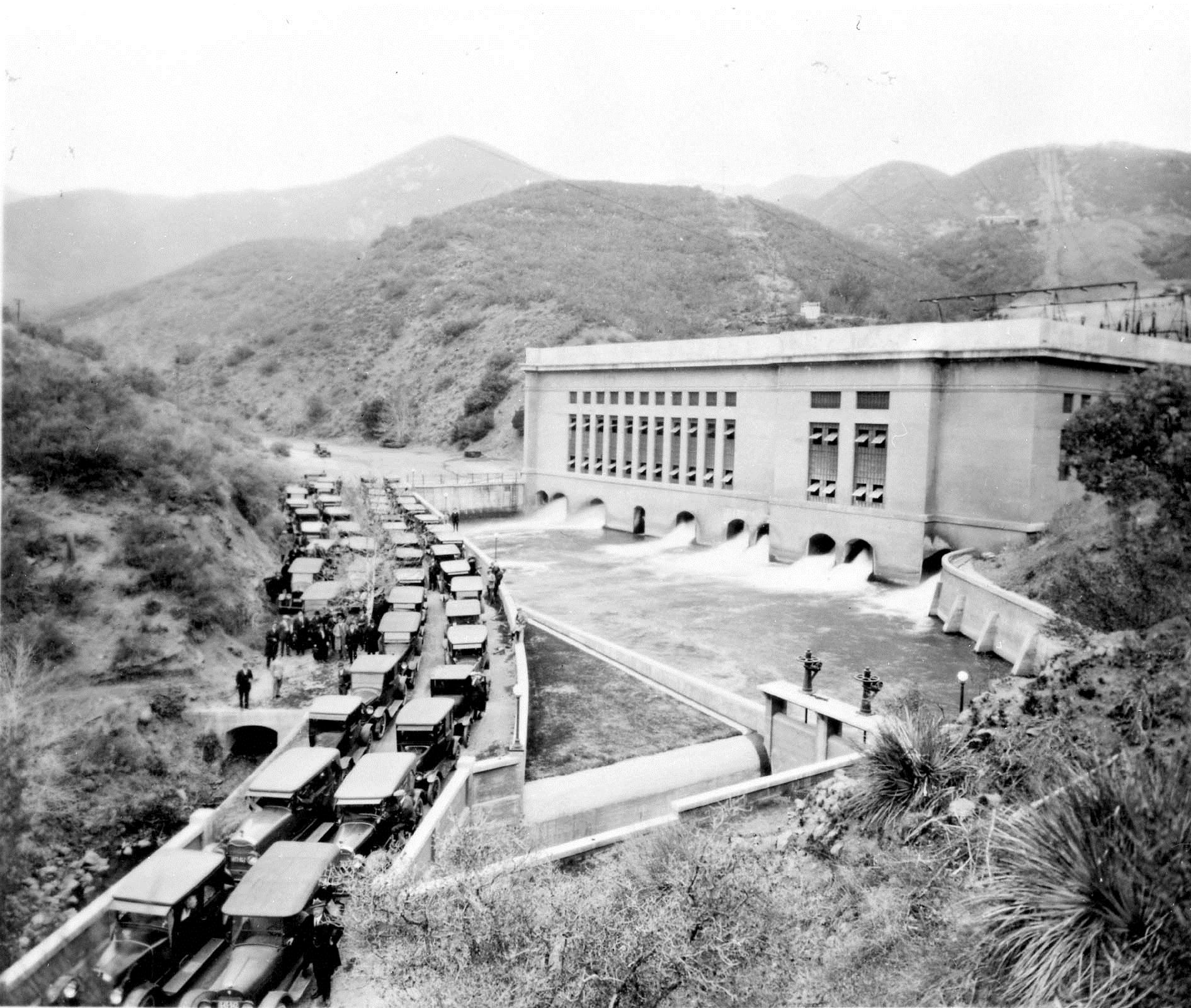 |
|
| (1917)* - Opening of the San Francisquito Power Plant No. 1 - Construction began in 1911 and took six years to complete. The plant’s opening on March 18, 1917 marked the beginning of Los Angeles’s independence as a public power producer. Within a year, it provided over 70 percent of the city’s electricity. The plant remains in operation today, producing a fraction of Los Angeles’s power needs. |
Historical BackgroundIn 1909, the Bureau of Los Angeles Aqueduct Power was created to design and build hydroelectric plants along the new aqueduct. When Los Angeles acquired water rights in the Owens Valley, it also secured power sites along the way. Ezra F. Scattergood, the Bureau’s first chief electrical engineer, led the effort to harness hydroelectric power and became the counterpart to William Mulholland, who oversaw the water system. Together they built the foundation for what would become the Los Angeles Department of Water and Power. |
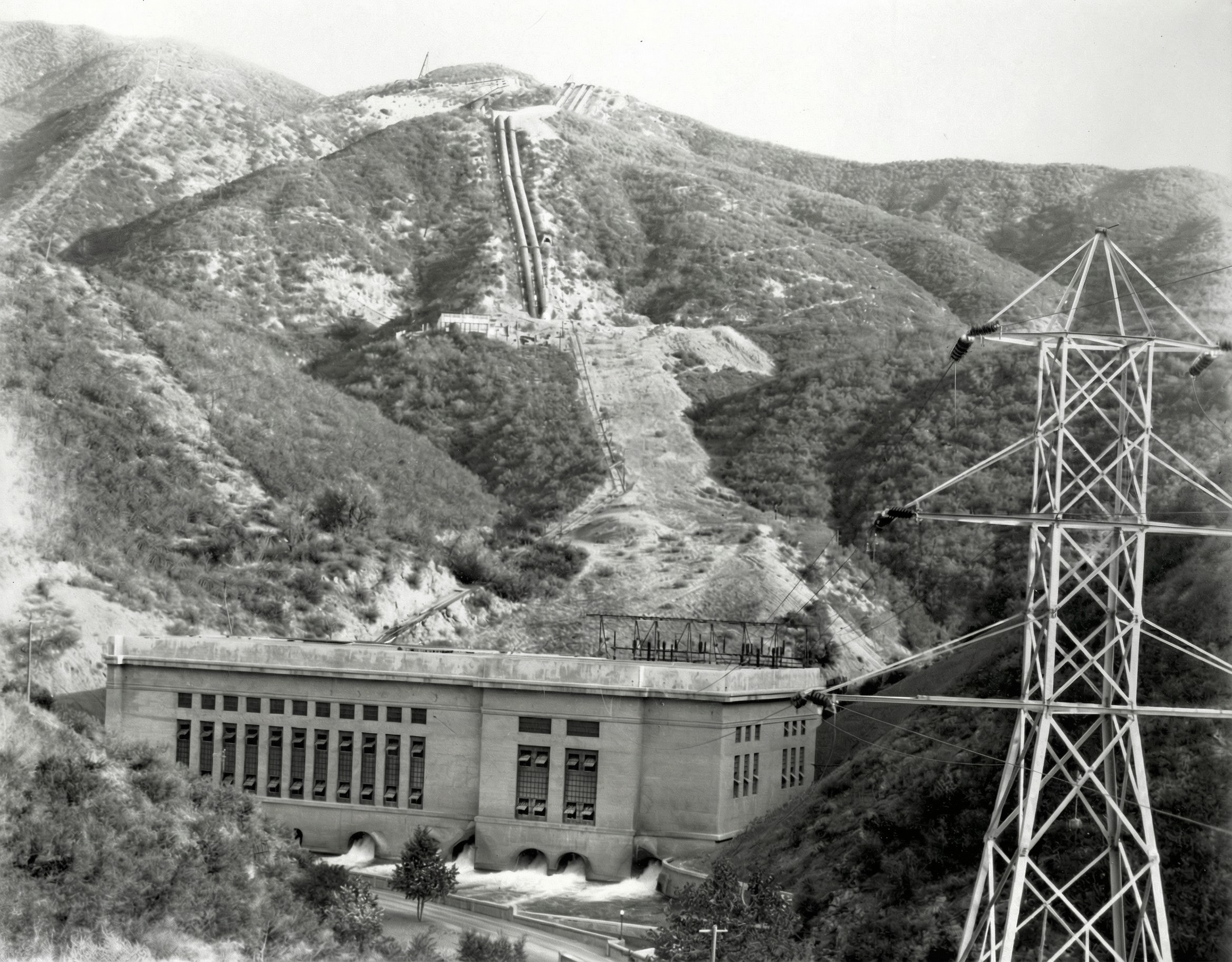 |
|
| (1928)* – View of Power Plant No. 1 and Transmission Tower - Seen here is Power Plant No. 1 in 1928 with its 115 kV transmission tower in the foreground. The penstocks at the top of the canyon carried water from the aqueduct down to the turbines, converting the water’s force into electricity for the city. |
Power Plants on the AqueductThe aqueduct system was extensively developed to take advantage of the drop in elevation as water descends from the High Sierras to Los Angeles. Up to 14 hydroelectric power plants were built along the Los Angeles Aqueduct. In 1908, the Division Creek Power Plant in Owens Valley became the first hydro-electric power plant to be constructed. It, along with the Cottonwood Power Plant, were built for the purpose of constructing the aqueduct. This was the first time electric energy had been used in such a construction project. |
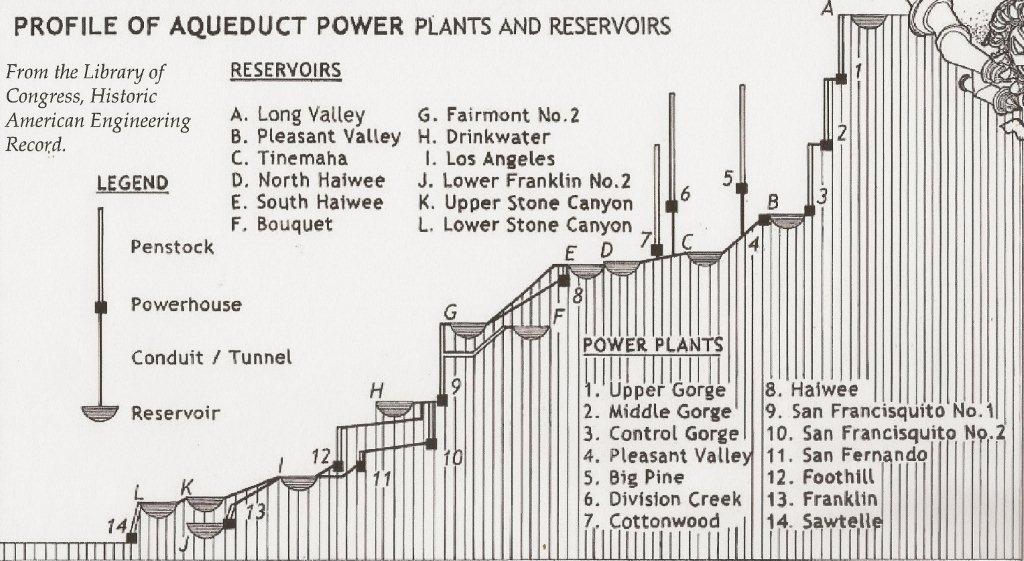 |
|
| Los Angeles Aqueduct Profile Diagram** |
Historical NotesThis diagram shows the route of the Los Angeles Aqueduct, where water flows entirely by gravity from 3,760 feet at Haiwee Reservoir down to 1,200 feet at Upper Van Norman Reservoir in the San Fernando Valley. The first two—Division Creek and Cottonwood—were constructed in 1908 in the Owens Valley to provide electricity for the aqueduct’s own construction work. This marked the first time electric energy was used on such a large engineering project. |
* * * * * |
Construction of Power Plant No. 1 (1911 - 1917)
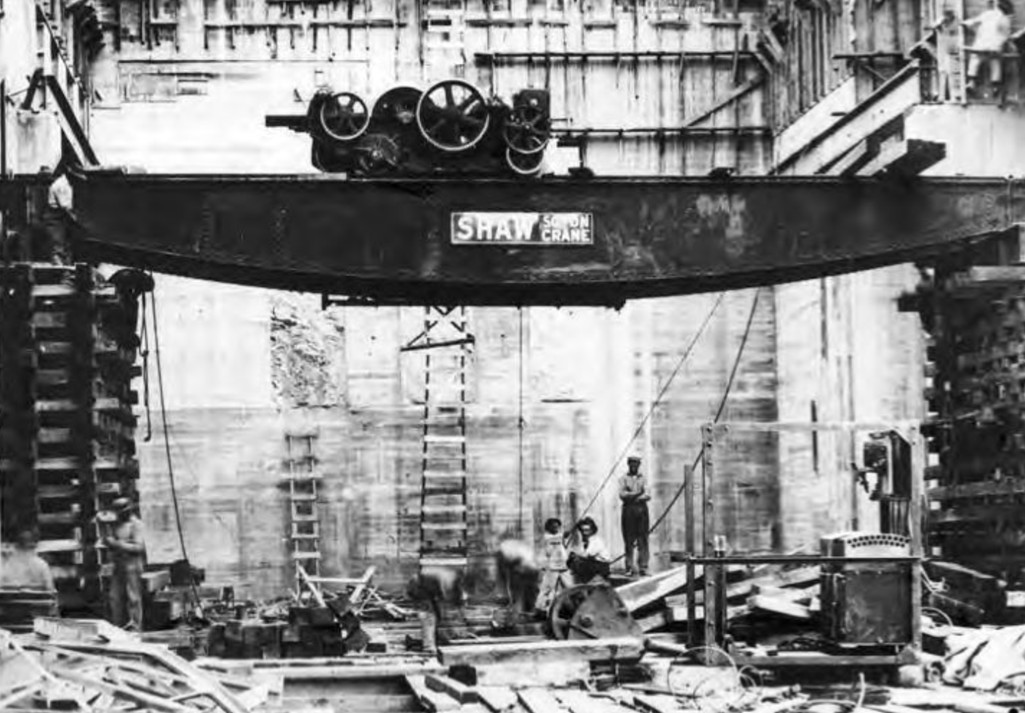 |
|
| (ca. 1916)* - Construction of Power Plant No. 1 |
Historical Notes Work on Power Plant No. 1 began about 1911. The project required tunnels, penstocks, concrete work, and heavy machinery never before used on such a scale in the canyon. |
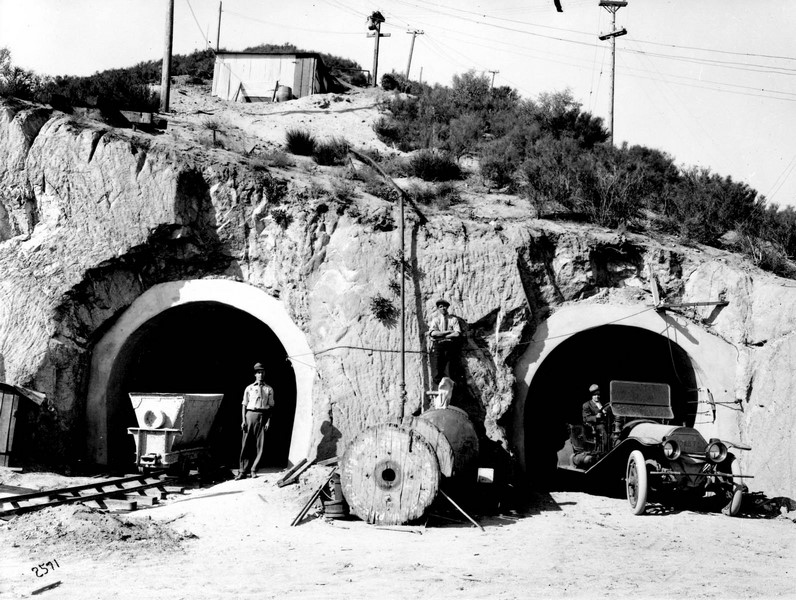 |
|
| (ca. 1916)* - Outlet Tunnels Lined with Cement |
Historical Notes The outlet tunnels that carried water to the turbines were lined with reinforced concrete to handle the tremendous pressure from the aqueduct above. |
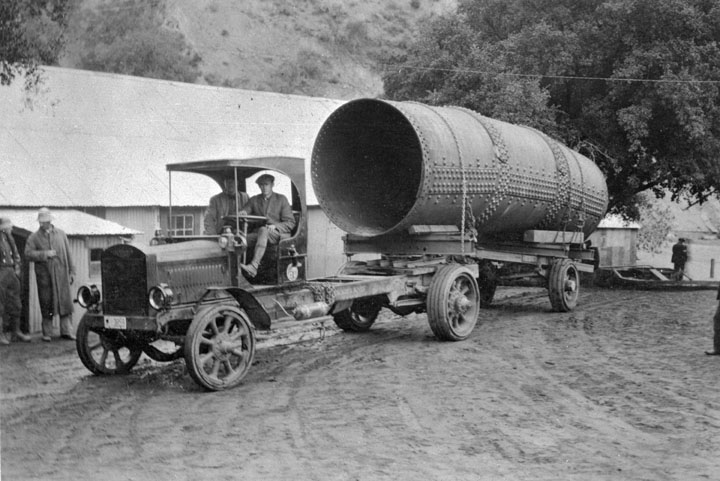 |
|
| (ca. 1916)* - Early Truck Hauling Penstock Section |
Historical Notes Trucks hauled the massive steel pipe sections—each up to eight feet in diameter—that formed the penstocks delivering water to the powerhouse below. |
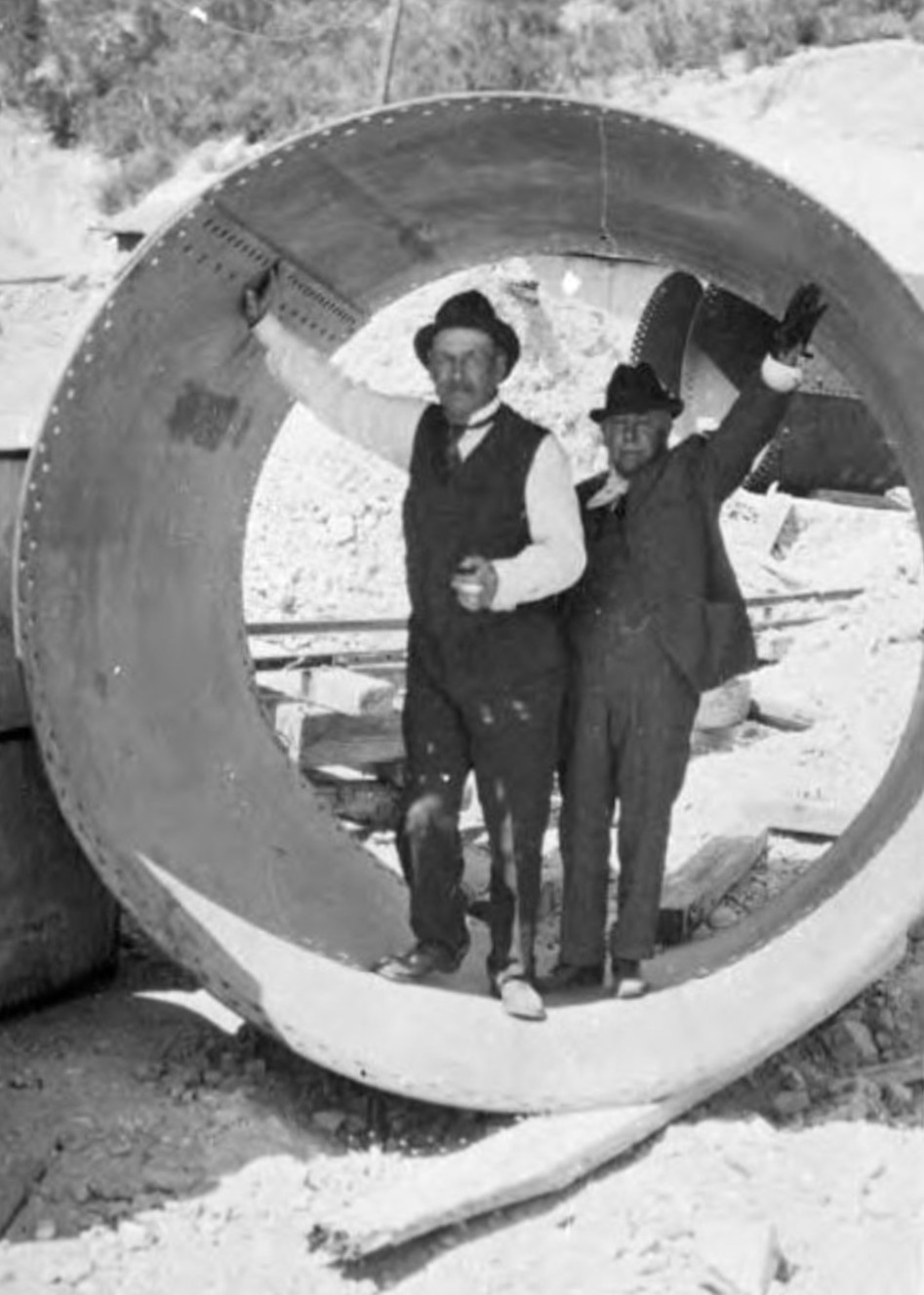 |
|
| (ca. 1916)* - Mulholland and Commissioner Del Valle in 80-Inch Pipe |
Historical Notes William Mulholland and Commissioner Del Valle inspect an 80-inch pipe section during construction. Their combined leadership linked Los Angeles’s water and power systems from the very beginning. |
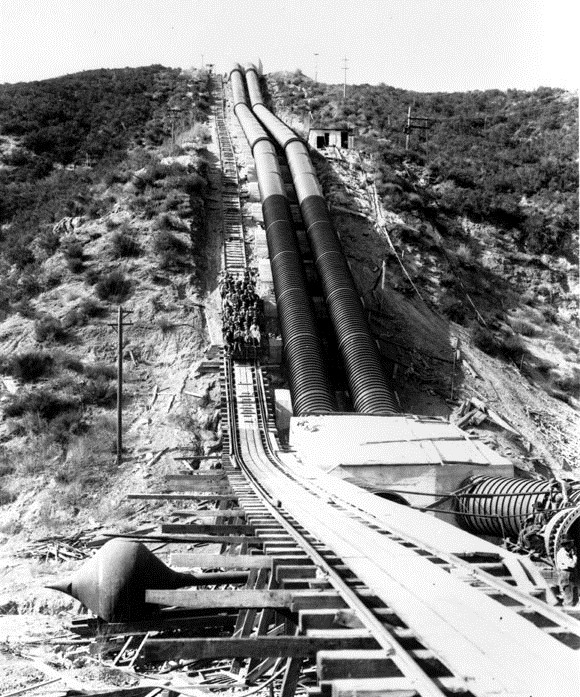 |
|
| (ca. 1916)* - Workers Assembling Penstocks |
Historical Notes Crews assemble penstock sections on the steep hillside above the powerhouse. A rail car at left transported both workers and materials up the incline. |
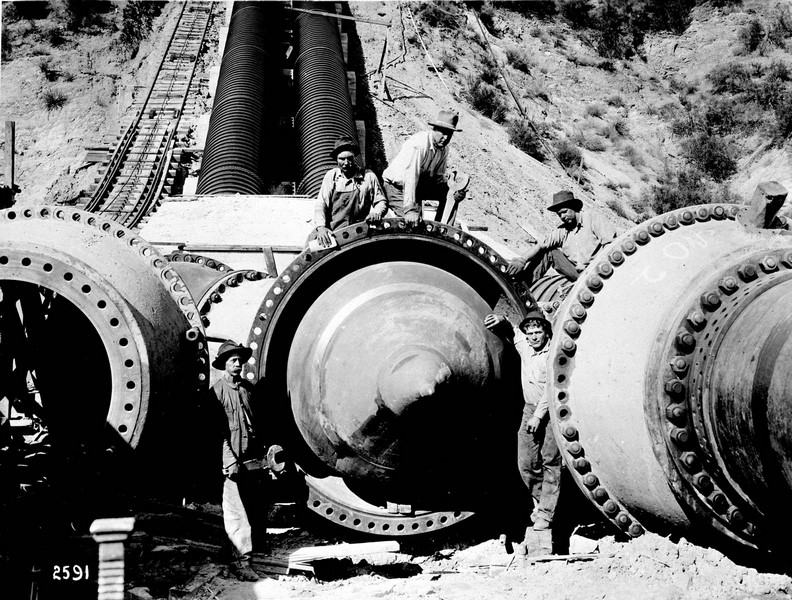 |
|
| (ca. 1916)* - Crew Posing on Completed Penstocks |
Historical Notes Construction workers pause for a group portrait in front of the newly assembled penstocks that would soon channel water to the Pelton turbines below. |
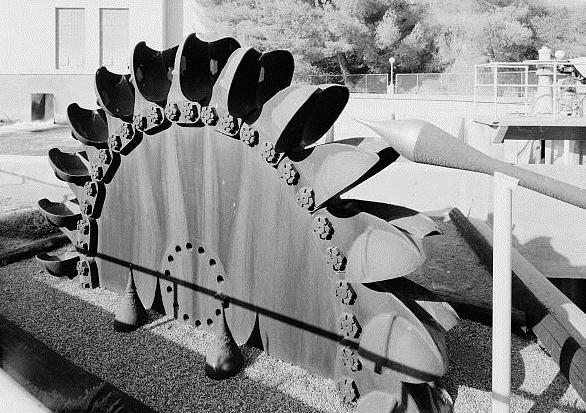 |
|
| (n.d.)** - Pelton Wheel Display |
Historical Notes The Pelton wheel used at Power Plant No. 1 extracted energy from the jet of high-velocity water striking its buckets. This impulse design produced much greater efficiency than older water-wheel systems. |
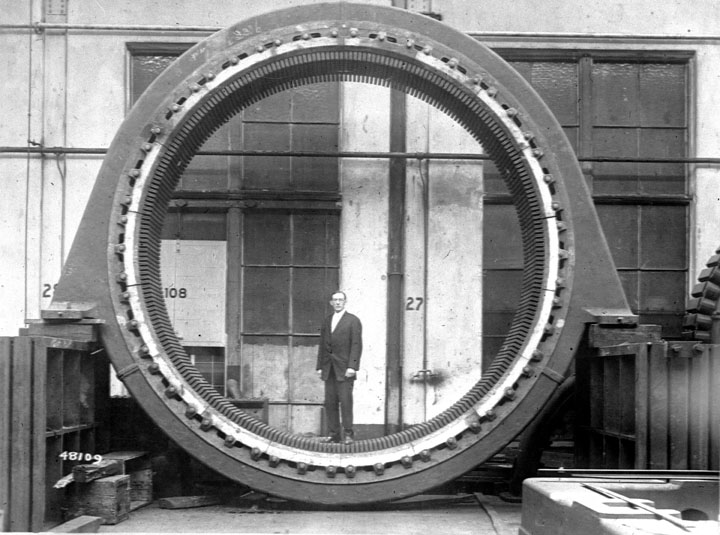 |
|
| (ca. 1916)* – Inside the Stator Ring |
Historical Notes A worker stands inside the large stator ring that would hold one of the plant’s main generators. The generator converted the turbine’s mechanical energy into electric power. |
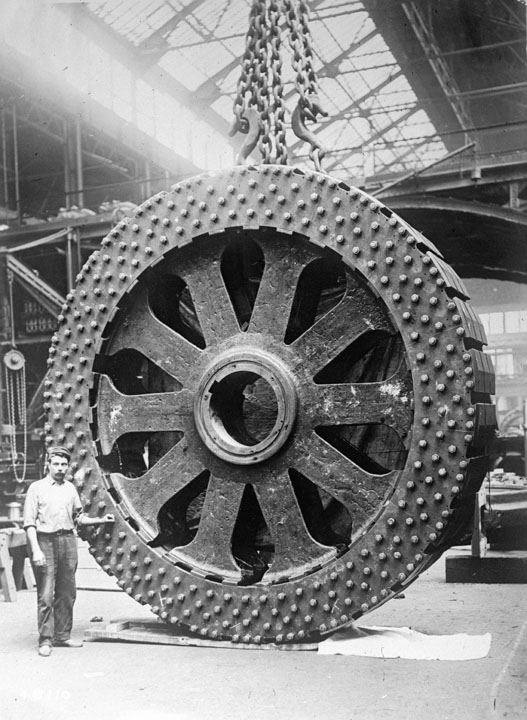 |
|
| (ca. 1916)* – Rotor Flywheel Preparation |
Historical Notes The massive rotor flywheel, shown here before installation, was part of the generator assembly that helped regulate speed and maintain steady electrical output. |
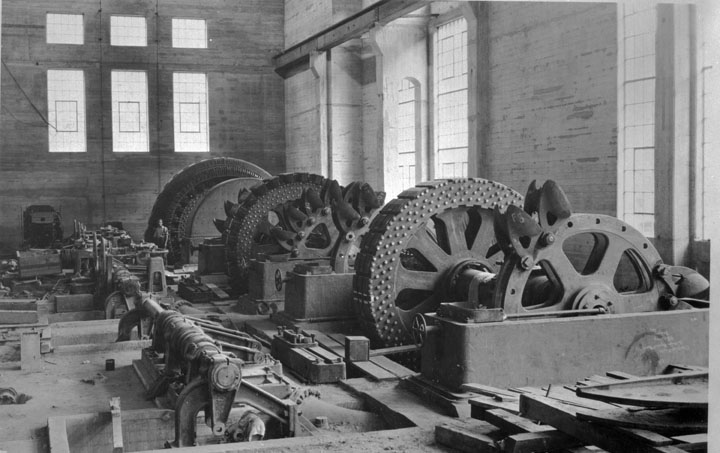 |
|
| (ca. 1916)* – Installation of Pelton Wheels |
Historical Notes Workers install the Pelton wheels that would spin as pressurized water from the penstocks struck their cups, driving the generators to produce electricity for Los Angeles. |
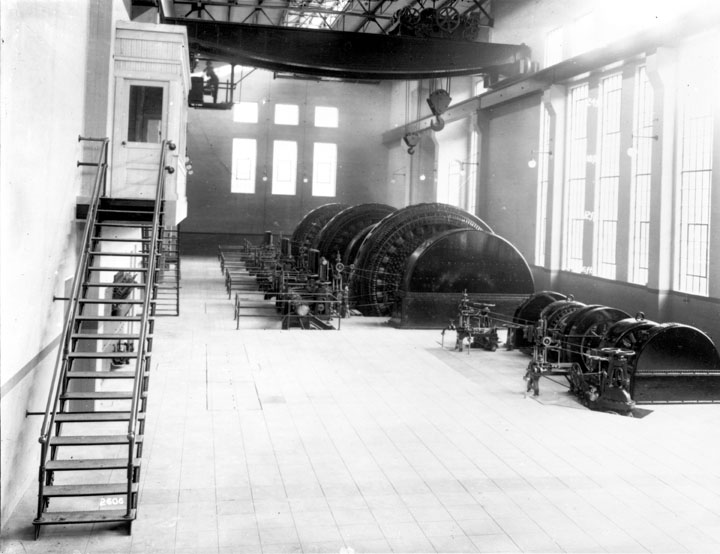 |
|
| (pre-1924)* – Interior of Power Plant No. 1 |
Historical Notes This early interior view shows the turbine-generator units shortly after completion. These machines provided dependable power to the growing city for decades. |
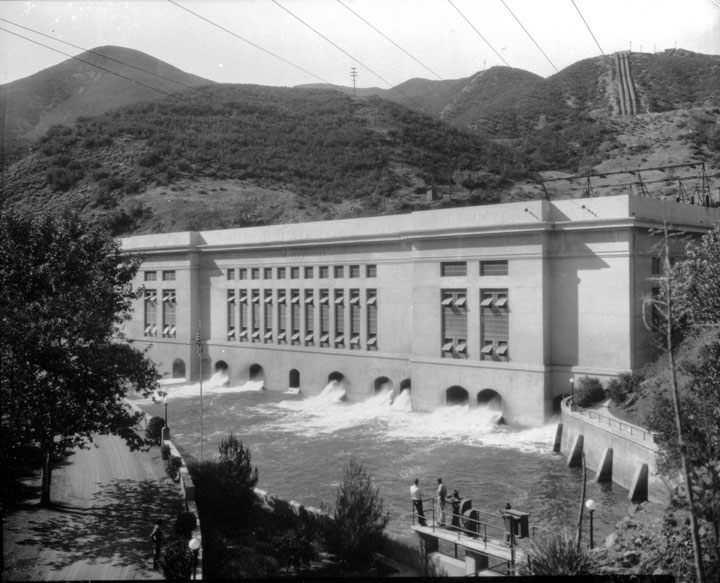 |
|
| (ca. 1917)* – Plant Nearing Completion |
Historical Notes On March 18, 1917 the San Francisquito Power Plant No. 1, Unit 1 was placed in service and energy was delivered to Los Angeles over a newly constructed 115 kV transmission line. The 200 kilowatts generated by Unit 1 were the first commercial kilowatts generated by the Los Angeles Bureau of Power and Light (Click HERE to see more in Early Power Transmission). Subsequently on April 28 and April 16, 1917, Units 2 and 3 respectively were placed in operation. The LA Bureau of Power and Light now had a source of low cost electricity and more than enough power to meet the City's needs. It would sell its excess San Francisquito generated power to Pasadena over two newly constructed 34 kV lines between the two cities. By 1917, World War I had forced the price of fuel oil to rise making the new lower cost hydroelectric power extremely desirable. |
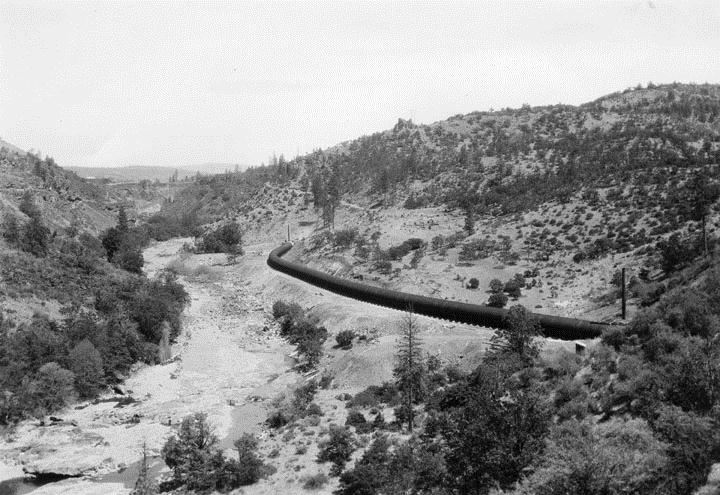 |
|
| (1926)* – Pipe Connecting Power Plant No. 1 to Power Plant No. 2 |
Historical Notes A quarter-mile-long, 16-foot-diameter pipe carried water from Power Plant No. 1 to Power Plant No. 2 downstream, allowing the same water to generate power twice before continuing toward the city. |
* * * * * |
Power Plant No. 2 (1928)
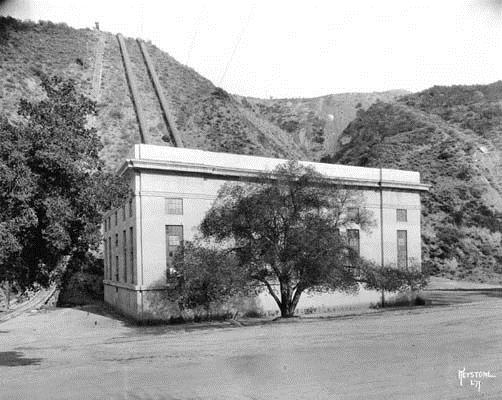 |
(1928)* - Power Plant No. 2 prior to the St. Francis Dam failure on March 12, 1928.
|
Historical Notes This station is about 1.3 miles downstream from where the St. Francis Dam stood. The building is 60 feet tall, but was destroyed by a wall of water that was 120 feet high. This photo was taken shortly before the St. Francis Dam failed.^ |
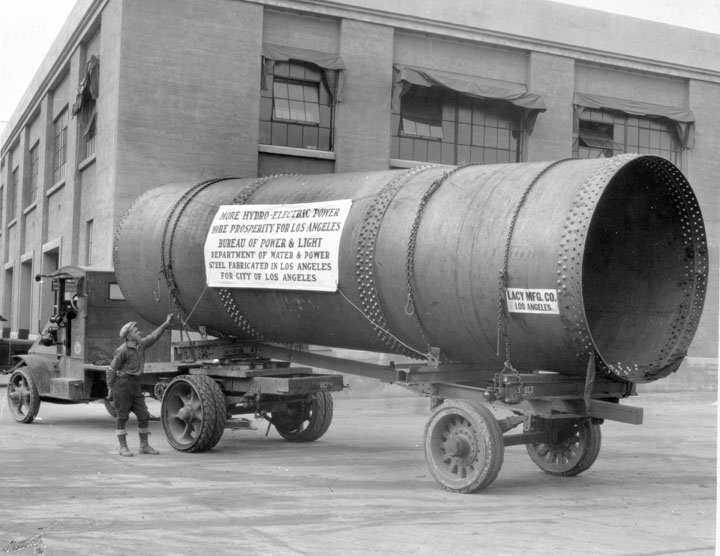 |
|
| (ca. 1928)* - New penstock section for Power Plant No. 2 |
 |
|
| (1928)* - A view of the bottom of the pit which looks like a small city with buildings, cars, trucks, and well as building equipment and supplies are all found here. Beyond those is a small encampment of tents for living and working during the reconstruction of Power Plant No. 2. |
Historical Notes Power Plant No. 2 was completely destroyed by the flood that swept through the canyon after the St. Francis Dam failed on March 12, 1928. You can clearly see how the hillside in the background has been stripped of all vegetation by the water, which came over the top of the hill upstream of the powerhouse. |
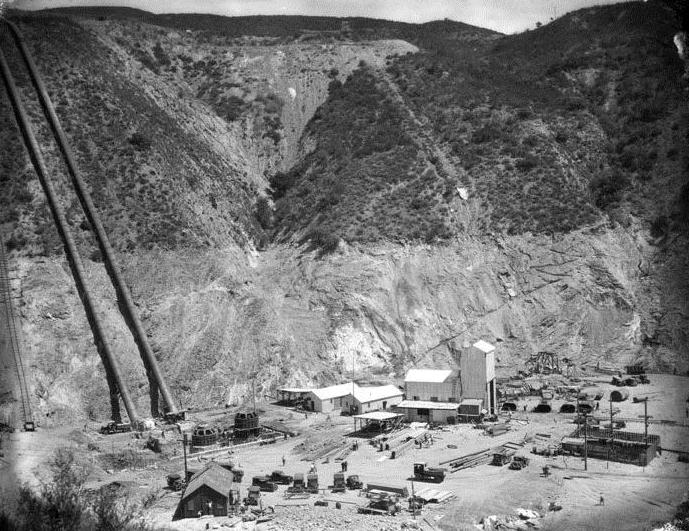 |
|
| (1928)^ - View showing the reconstruction of Power Plant No. 2 in San Francisquito Canyon after the St. Francis Dam disaster. The water line of the flood can be seen on the face of the mountains. |
Click HERE to read see more in the St. Francis Dam Disaster |
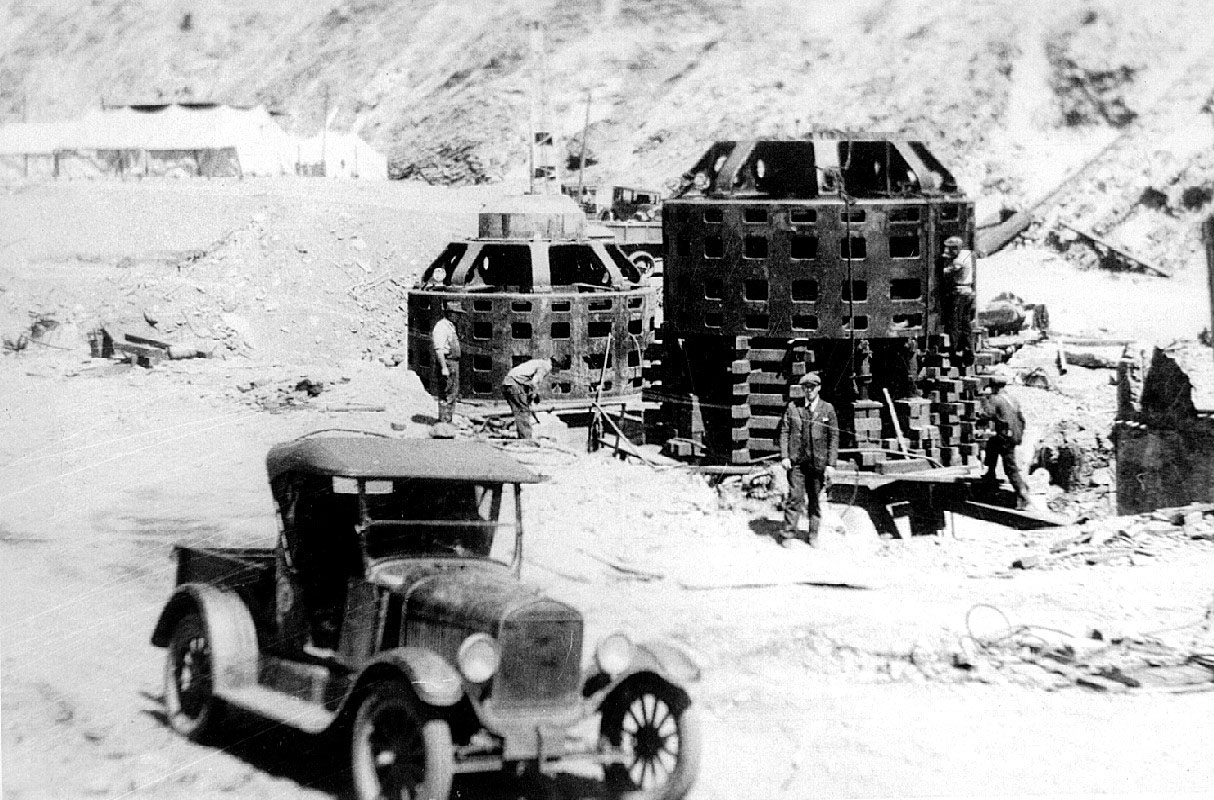 |
|
| (1928)^ – Ground view showing workers positioning the second of two turbine-generators into its final position during the reconstruction of Power Plant No. 2. |
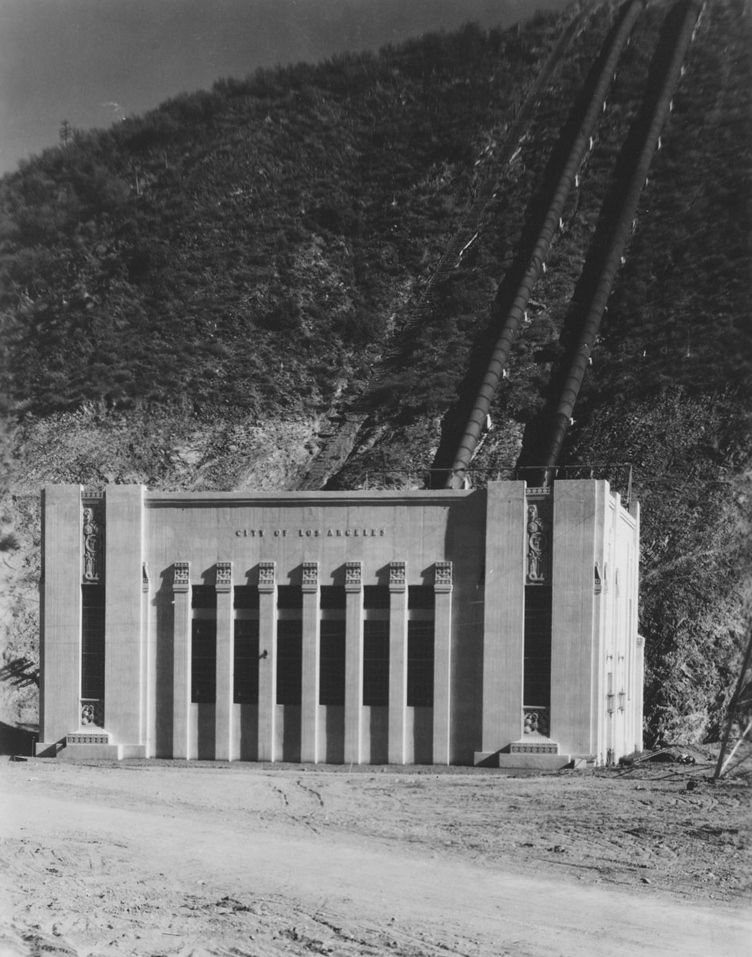 |
|
| (ca. 1929)* - Photograph of the new building of the San Francisquito Canyon Hydro-Power Plant (Power Plant No. 2) after it was reconstructed. |
Historical Notes Power Plant No. 2 was completely restored and back in service by November 1928, just 8 short months after the original plant was destroyed in the St. Francis Dam Disaster. |
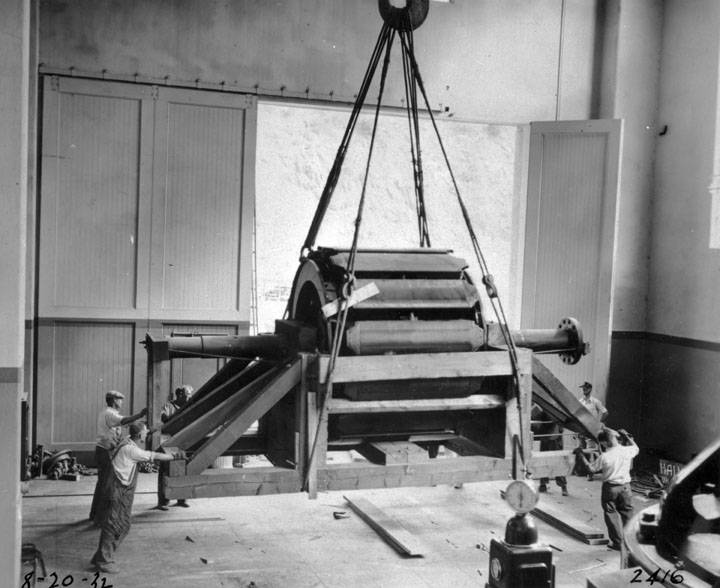 |
|
| (1932)* - View of the new rotor being prepared for installation in the 3rd generating unit at Power Plant No. 2. |
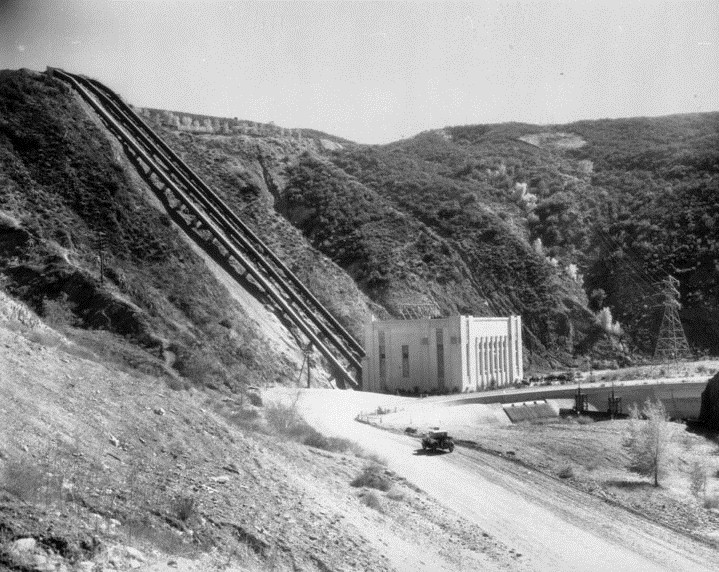 |
|
| (1930s)^ - This photo shows the rebuilt Power Plant No. 2 after the addition of a 3rd generating unit. Note the additional penstock. |
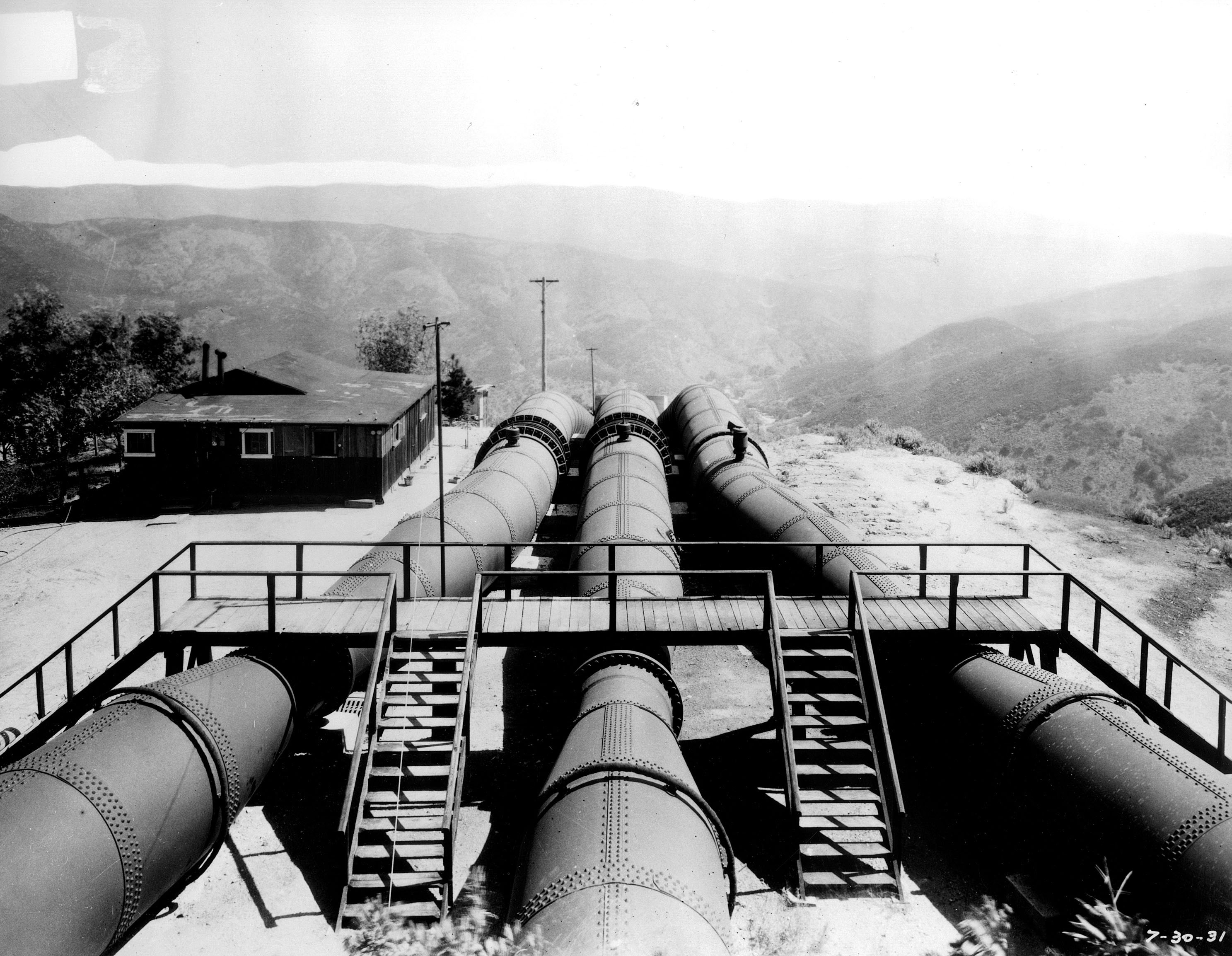 |
|
| (1931)^ - View showing the three penstocks at the top of the hill as they turn down toward Power Plant No. 2. |
San Fernando Power Plant
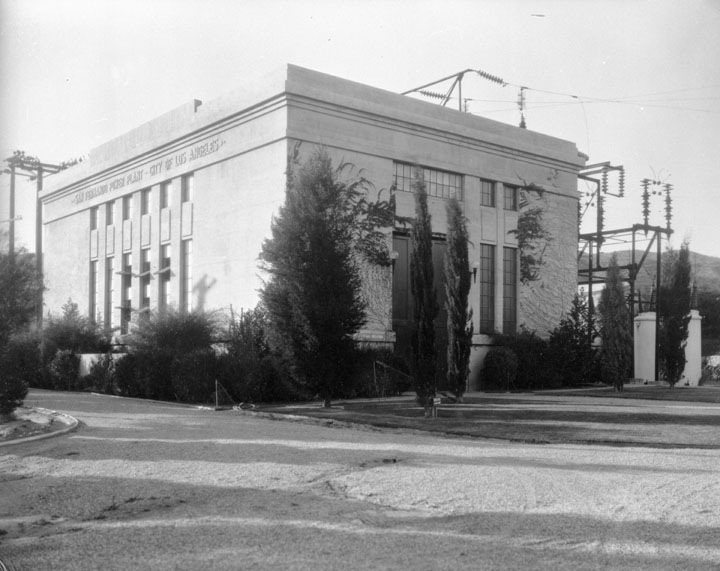 |
|
| (n.d.)* - Exterior view of the San Fernando Power Plant |
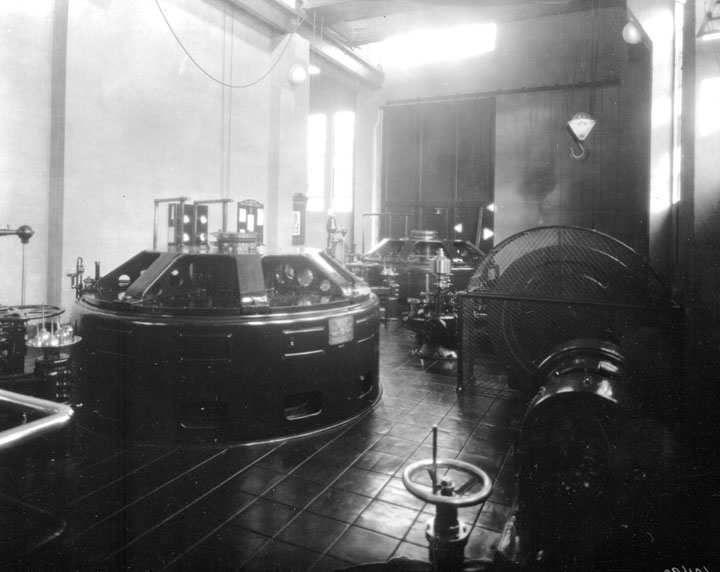 |
|
| (n.d.)* - Inerior view of the San Fernando Power Plant. |
Owens Valley Power Plants
Haiwee Power Plant
 |
|
| (n.d.)* - Exterior view of Haiwee Power Plant |
 |
|
| (n.d.)* - Haiwee Power Plant interior. |
Cottonwood Power Plant (1908)
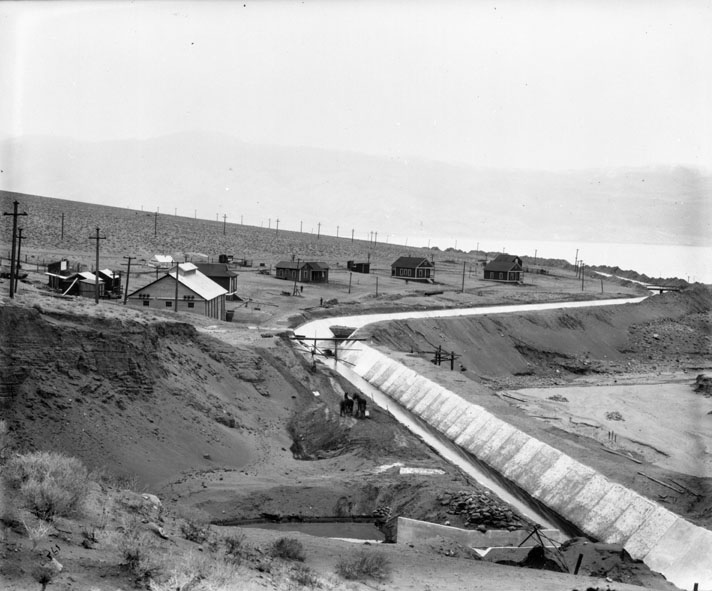 |
|
| (ca. 1909)* - View looking at Cottonwood Power Plant which provided power for the construction of the LA Aqueduct. Power lines can be seen winding down toward the Owens Valley floor. |
From the LADWP Historic Archive Although it wasn’t the first City power plant, it’s the oldest in operation and began service even before transmission lines crossed mountains and desert to deliver its power to Los Angeles. Located south of Olancha and north of Haiwee Reservoir, the power plant was designed by DWP power pioneer Carl A. Heinze to tap the energy of rushing Cottonwood Creek which is diverted to a flume four miles up Cottonwood Canyon in the Sierras. From the flume, water is carried to a forebay behind the plant and then sent through penstocks to the turbines under a 1,200-foot head. Only a few yards form the plant’s tailrace, the water flows directly into the Aqueduct.^ |
 |
|
| (ca. 1909)* - Cottonwood started generating 900 kilowatts of hydroelectric power along the Los Angeles Aqueduct on November 13, 1908, supplying energy to run equipment during the Aqueduct construction from Owens Valley through the Mojave Desert. |
 |
|
| (1912)^* – Postcard view showing the completed Cottonwood Power Plant with snow-capped mountains seen in the background. |
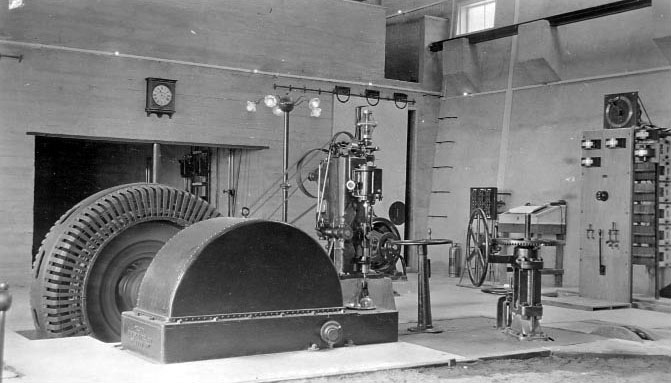 |
|
| (1909)*^ - Interior view of Cottonwood Power Plant showing generator and controls. |
From the LADWP Historic Archive Power from Cottonwood’s first generator and a second 900-kilowatt unit placed into service October 13, 1909, first traveled over temporary transmission lines to power the Aqueduct dredging operations and later to power equipment at the Monolith cement plant near Mojave which produced millions of tons of cement for miles of the Aqueduct’s concrete-lined conduit and canal sections.^ |
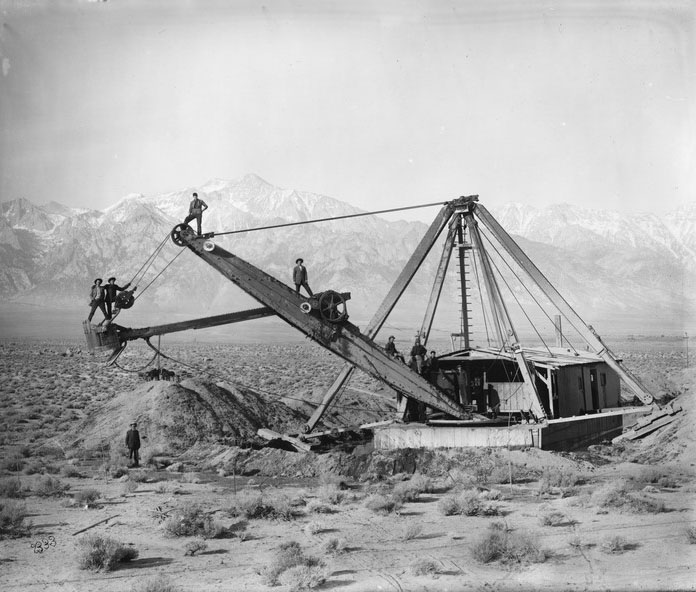 |
|
| (ca. 1910)* - The electric dredge displaced millions of cubic feet of earth in construction of the LA Aqueduct. |
Division Creek Power Plant No. 1 (1908)
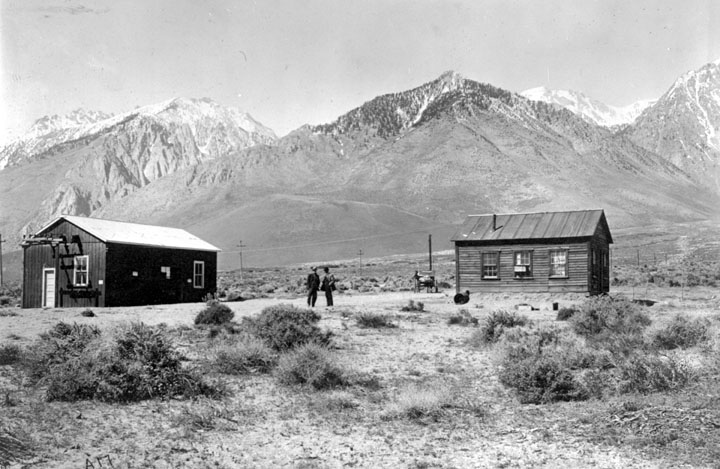 |
|
| (Early 1900s)* - Division Creek Power Plant No. 1. A small frame building with a tiny 120-kilowatt generator constituted the first power plant for Los Angeles, Division Creek Power Plant No. 1. Located south of Bishop, California, it began operation in 1909. |
From the LADWP Historic Archive In April 1908, in the shadow of the towering snow-clad High Sierra, the Division Creek Power Plant No. 1, Los Angeles’ first municipal power plant, was placed in operation. |
Big Pine Power Plant (1925)
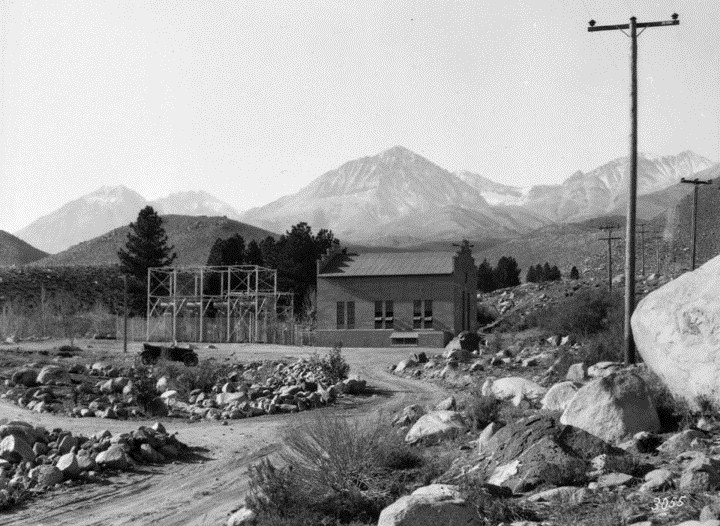 |
|
| (1925)* - Big Pine Power Plant No. 3 - It is the largest of six power plants on the 200-mile electric system which the City of Los Angeles owns and operates in Owens Valley. Big Pine No. 3 Power Plant is equipped with a 4,000-horsepower Pelton Water Wheel and a 4,000 K.V.A General Electric Generator which feeds into the 33,000-volt valley electric system of the Water Department through an outdoor step-up transformer station. ^ |
Big Pine Power Plant (1928)
.jpg) |
|
| (1928)* - Big Pine Power Plant is operated by the Municipal Bureau of Power and Light. |
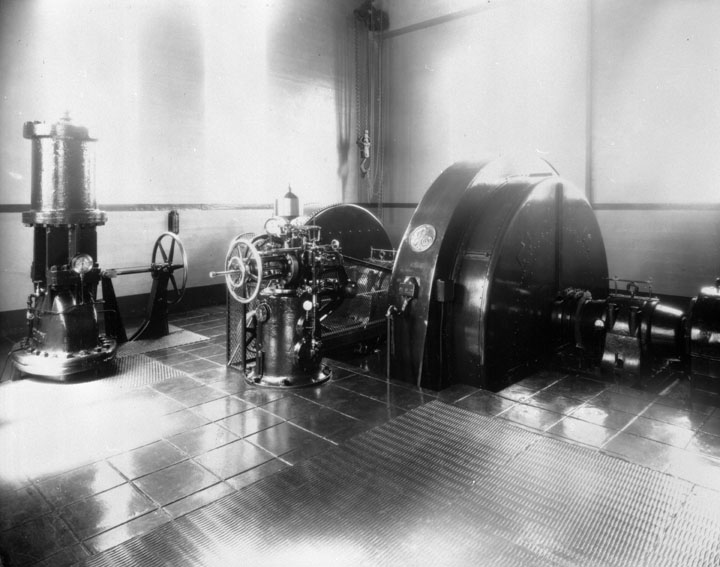 |
|
| (n.d.)* - Big Pine Power Plant Interior |
Upper Gorge Power Plant
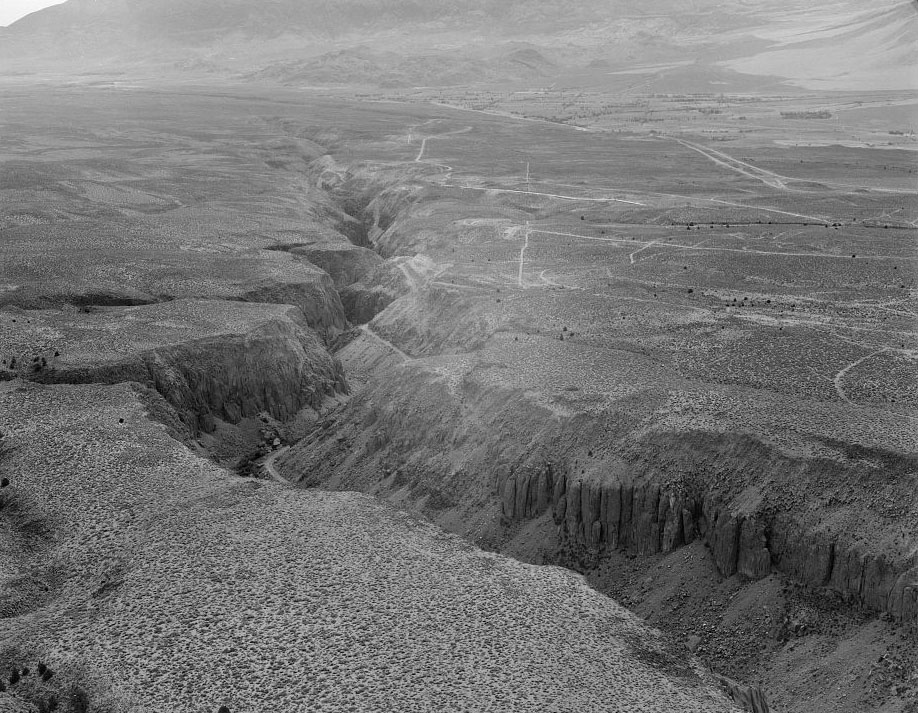 |
|
| (n.d.)** - Owens River Gorge looking northeast. |
Historical Notes The Owens River Gorge is a natural canyon carved by the river as it passed through the volcanic tablelands at the northern end of the Owens Valley. This landform, a giant, sloping volcanic scab, was formed on top of the existing valley floor 760,000 years ago by the eruption of the nearby Long Valley Caldera. DWP built three hydropower plants in the gorge, to take advantage of the 2,300 foot drop between Crowley Lake and the Owens River Valley. Between the plants, river water is diverted into pipelines in order to increase the velocity of the water flow, thereby increasing power.^^ |
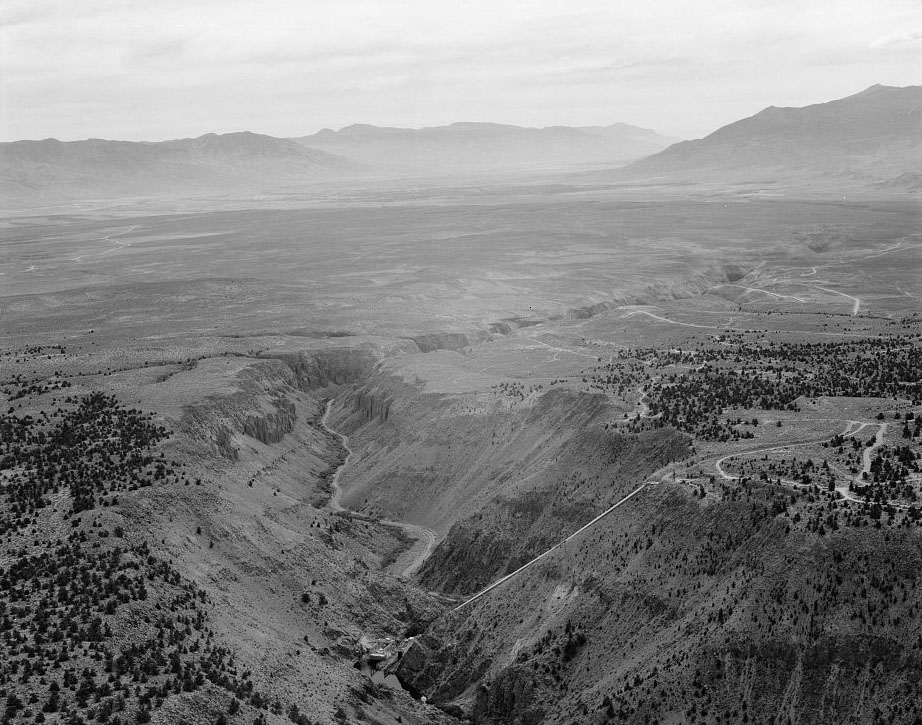 |
|
| (n.d.)** - Upper Gorge Power Plant looking southeast down the gorge. |
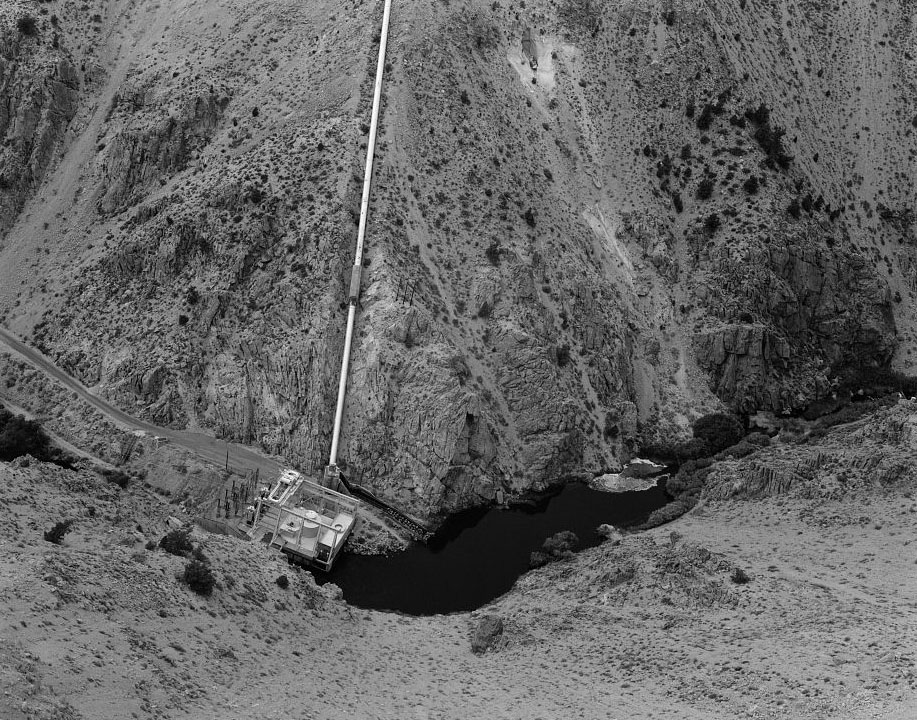 |
|
| (n.d.)** - Closer view of the Upper Gorge Power Plant showing penstock on the side of the canyon walls. |
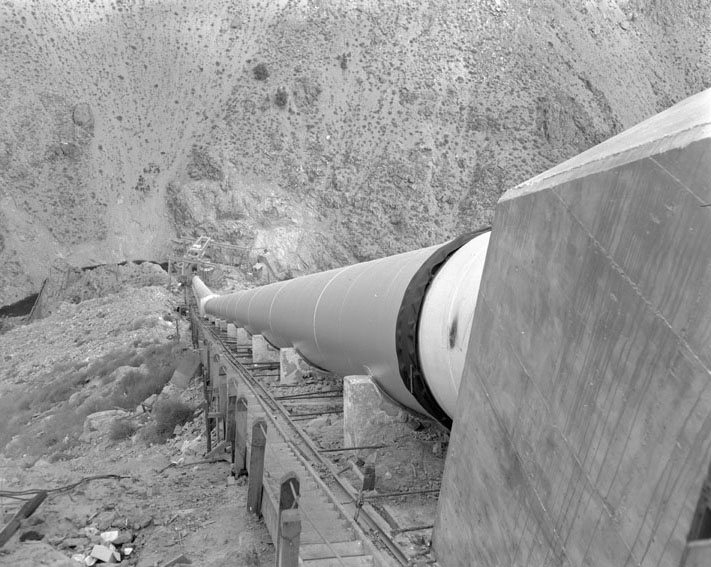 |
|
| (n.d.)* - View of penstock running down to Upper Gorge Power Plant. |
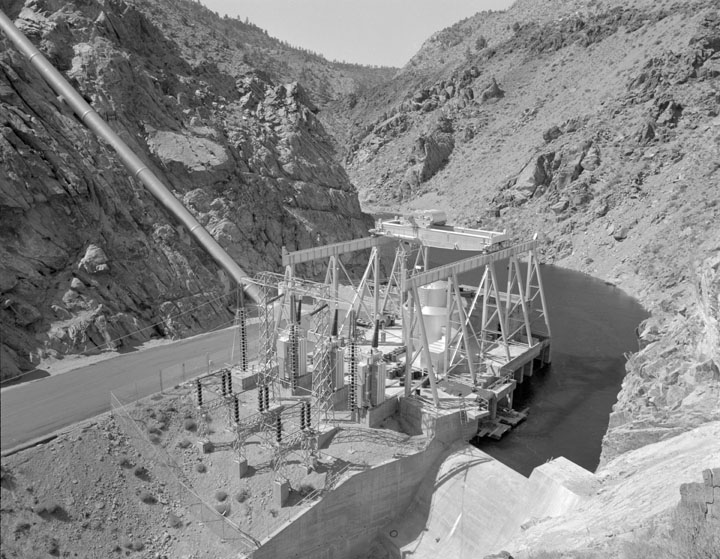 |
|
| (n.d.)* - View of the Upper Gorge Power Plant. It's large penstock can be seen to the left. |
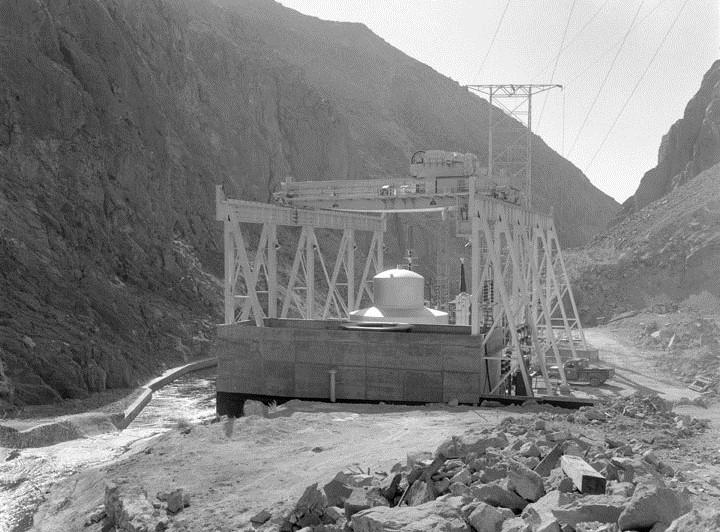 |
|
| (n.d.)* - Close-up view of the Upper Gorge Power Plant. |
Middle Gorge Power Plant
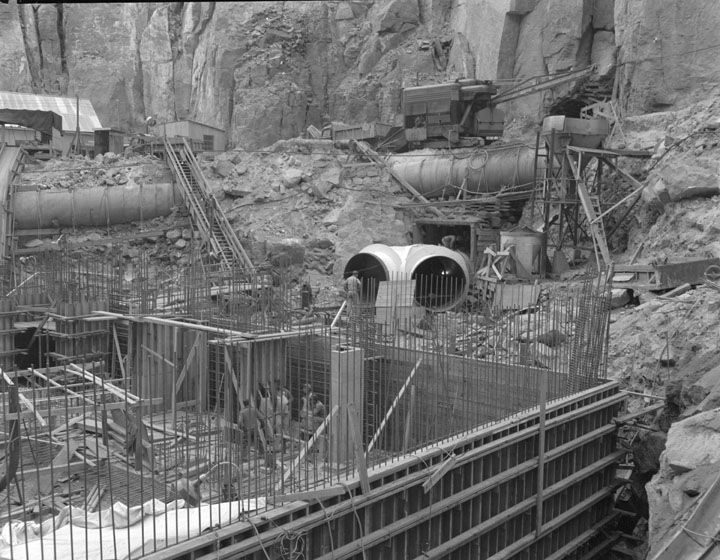 |
|
| (1940s)^ - View of the Middle Gorge Power Plant under construction showing the large penstocks before they are completely buried. |
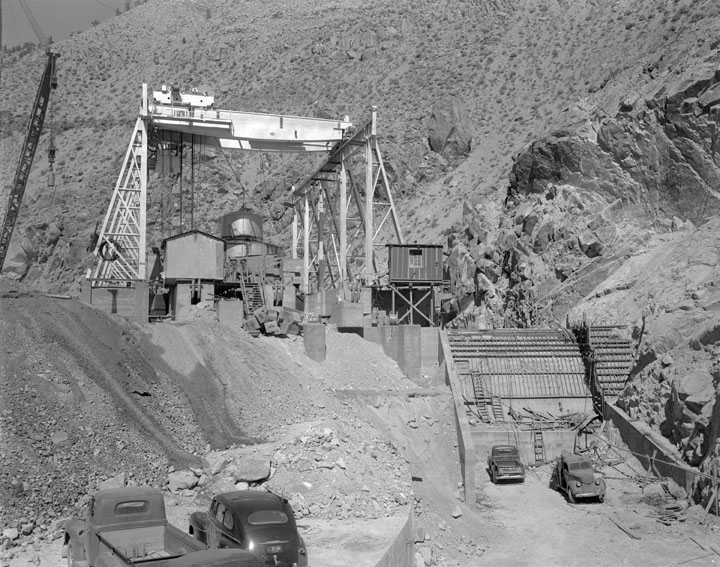 |
|
| (1940s)^ - View of the nearly completed Middle Gorge Power Plant. The spillway on the right is getting its last finishing touches. |
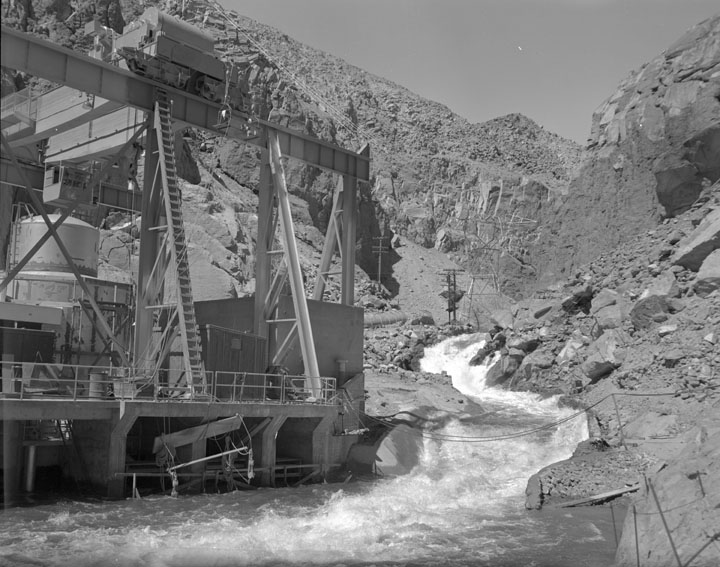 |
|
| (1940s)^ - View of the completed Middle Gorge Power Plant with water flowing over its spillway. |
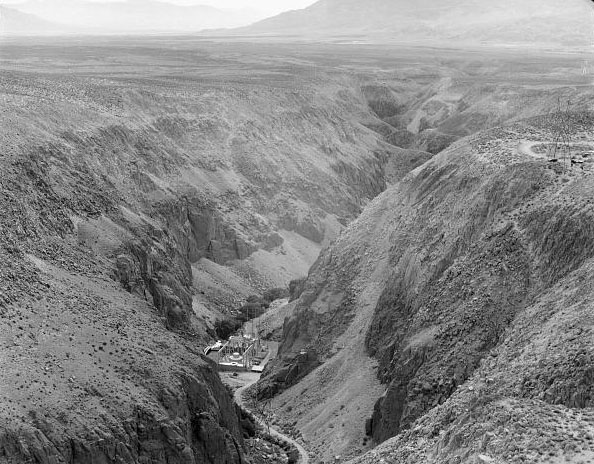 |
|
| (n.d.)** - Middle Gorge Power Plant looking northeast from high above. |
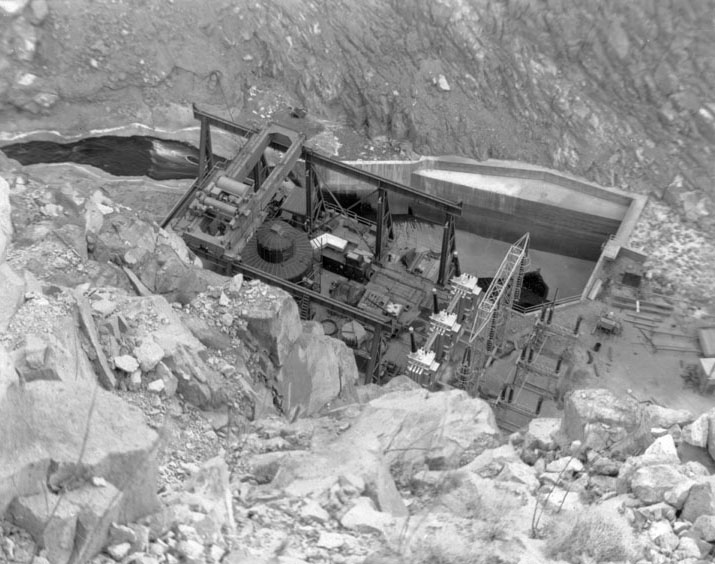 |
|
| (n.d.)^ - View of the MIddle Gorge Power Plant the top of the canyon directly above. |
Gorge Power Plant No. 3 (1951)
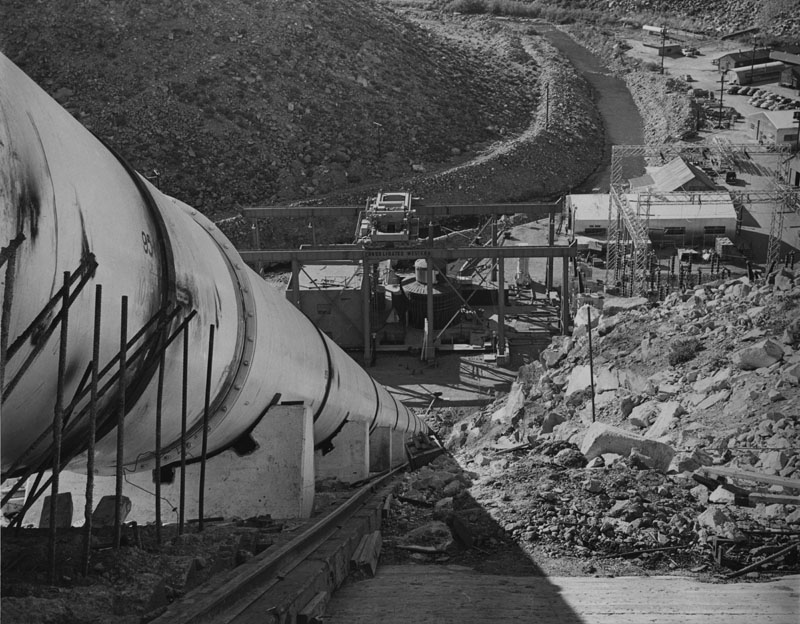 |
|
| (1951)* - Looking down along this 95-inch welded steel penstock, the recently completed Owens Gorge Power Plant No. 3 is seen on the bank of the river. The river is diverted through the penstock to turn the rotor of the 37,500-kilowatt generator. The switching rack to the right starts the power on its 258-mile journey over the 230,000-volt transmission line to Los Angeles.* |
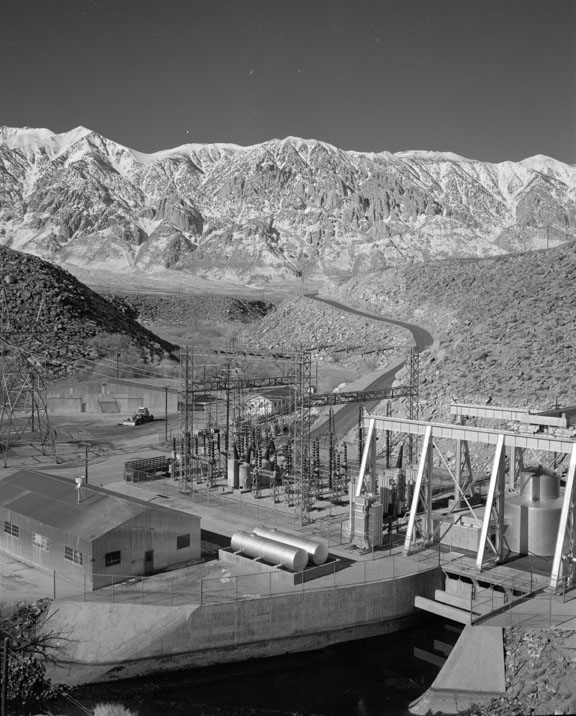 |
|
| (n.d.)^ - View of the Control Gorge Power Plant at dusk with access road in the background. The beautiful snow-capped mountains can be seen in the background. |
Click HERE to see more in Early Power Generation |
* * * * * |
Please Support Our CauseWater and Power Associates, Inc. is a non-profit, public service organization dedicated to preserving historical records and photos. We are of the belief that this information should be made available to everyone—for free, without restriction, without limitation and without advertisements. Your generosity allows us to continue to disseminate knowledge of the rich and diverse multicultural history of the greater Los Angeles area; to serve as a resource of historical information; and to assist in the preservation of the city's historic records.
|
History of Water and Electricity in Los Angeles
More Historical Early Views
Newest Additions
Early LA Buildings and City Views
* * * * * |
References and Credits
* DWP - LA Public Library Image Archive
^^Varnelis.net: Owens Gorge Power Plants
^*Claremont Colleges Digital Library
**Library of Congress Image Archive; Los Angeles Aqueduct, From Lee Vining Intake (Mammoth Lakes) to Van Norman Reservoir Complex (San Fernando Valley)
< Back
Menu
- Home
- Mission
- Museum
- Major Efforts
- Recent Newsletters
- Historical Op Ed Pieces
- Board Officers and Directors
- Mulholland/McCarthy Service Awards
- Positions on Owens Valley and the City of Los Angeles Issues
- Legislative Positions on
Water Issues
- Legislative Positions on
Energy Issues
- Membership
- Contact Us
- Search Index